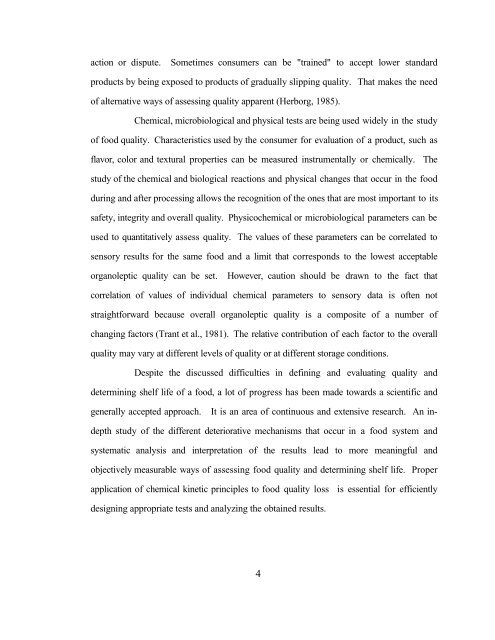the handbook of food engineering practice crc press chapter 10 ...
the handbook of food engineering practice crc press chapter 10 ...
the handbook of food engineering practice crc press chapter 10 ...
Create successful ePaper yourself
Turn your PDF publications into a flip-book with our unique Google optimized e-Paper software.
action or dispute. Sometimes consumers can be "trained" to accept lower standard<br />
products by being exposed to products <strong>of</strong> gradually slipping quality. That makes <strong>the</strong> need<br />
<strong>of</strong> alternative ways <strong>of</strong> assessing quality apparent (Herborg, 1985).<br />
Chemical, microbiological and physical tests are being used widely in <strong>the</strong> study<br />
<strong>of</strong> <strong>food</strong> quality. Characteristics used by <strong>the</strong> consumer for evaluation <strong>of</strong> a product, such as<br />
flavor, color and textural properties can be measured instrumentally or chemically. The<br />
study <strong>of</strong> <strong>the</strong> chemical and biological reactions and physical changes that occur in <strong>the</strong> <strong>food</strong><br />
during and after processing allows <strong>the</strong> recognition <strong>of</strong> <strong>the</strong> ones that are most important to its<br />
safety, integrity and overall quality. Physicochemical or microbiological parameters can be<br />
used to quantitatively assess quality. The values <strong>of</strong> <strong>the</strong>se parameters can be correlated to<br />
sensory results for <strong>the</strong> same <strong>food</strong> and a limit that corresponds to <strong>the</strong> lowest acceptable<br />
organoleptic quality can be set. However, caution should be drawn to <strong>the</strong> fact that<br />
correlation <strong>of</strong> values <strong>of</strong> individual chemical parameters to sensory data is <strong>of</strong>ten not<br />
straightforward because overall organoleptic quality is a composite <strong>of</strong> a number <strong>of</strong><br />
changing factors (Trant et al., 1981). The relative contribution <strong>of</strong> each factor to <strong>the</strong> overall<br />
quality may vary at different levels <strong>of</strong> quality or at different storage conditions.<br />
Despite <strong>the</strong> discussed difficulties in defining and evaluating quality and<br />
determining shelf life <strong>of</strong> a <strong>food</strong>, a lot <strong>of</strong> progress has been made towards a scientific and<br />
generally accepted approach. It is an area <strong>of</strong> continuous and extensive research. An indepth<br />
study <strong>of</strong> <strong>the</strong> different deteriorative mechanisms that occur in a <strong>food</strong> system and<br />
systematic analysis and interpretation <strong>of</strong> <strong>the</strong> results lead to more meaningful and<br />
objectively measurable ways <strong>of</strong> assessing <strong>food</strong> quality and determining shelf life. Proper<br />
application <strong>of</strong> chemical kinetic principles to <strong>food</strong> quality loss is essential for efficiently<br />
designing appropriate tests and analyzing <strong>the</strong> obtained results.<br />
4














